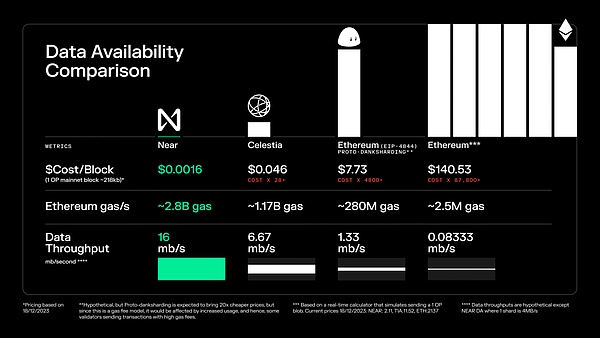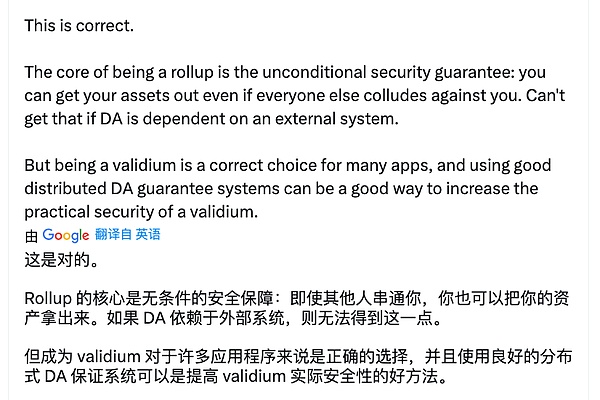Author: Lanli Source: X, @yorkzhong
1. Components of modular blockchain:
⇒Execution layer: strong>Rollup/ L2/L3, execute the calculations required by the user/smart contract, understood as a computer
⇒DA: All original transactions of the execution layer must be stored here for later verification and confirmation, which can be understood as a database
⇒Settlement/Settlement:< /strong>Verification/Confirmation/Finality, the user can initiate a rebuttal here, which requires the original execution layer data stored in DA
⇒Also One layer is the consensus layer:This is mainly the content of Layer 1 and will not be described in detail here.
2. Three levels of main technology stacks or representative products:
⇒OP Stack
⇒ZK Stack
⇒Cosmos Stack< /p>
⇒Eth layer1
⇒Dymension (settlement in cooperation with Celestia)
⇒Layer2 itself (such as Arbitrum, which can be used as a settlement of the secondary Layer3)
⇒ETH blob/ Danksharding
⇒Celestia (independent decentralized DA)
⇒Near DA
⇒EigenDA/MantleDA (DA using ETH restaking)
⇒Centralized DA (Validum mode)
Figure 1 is a comparison of different DAs made by Near. There is also an ultimate state of danksharding in Ether, which is of course reasonable, because Ether has not yet determined the timetable for danksharding (the Cancun upgrade is 4844, prototype Danksharding).

From a technical perspective, Ethereum Danksharding and Celestia are the most decentralized,because they both use sampling technology, which reduces the performance requirements of nodes. Large bandwidth can be achieved at the same time.
EigenDA is second, and also uses sampling, but EigenDA is parasitic on the ether, and its node number Is a subset of ether.
Others should not use sampling. For example, the degree of decentralization of NearDA is equivalent to that of Near The degree of decentralization of Protocol.
3. How to combine modular blockchains:
The above creates approximately 3 * 3 * 5 = 45 possible combinations, for example:
⇒Arbitrum: OP (execution layer technology stack)+ETH L1 (settlement layer)+ETH blob (DA)
⇒Mantle: OP +ETH L1+MantleDA
⇒XAI: OP + Arbitrum L2 + Third-party DA
It can be said that a hundred flowers are blooming
4. The security differences of different modes
What is the difference between these different combinations? In addition to the differences in fees and TPS, the Ethereum system will of course maintain the "legitimacy" of Ethereum. For example, Vitalik believes that if Ethereum's DA is not used, Ethereum cannot guarantee the safe withdrawal of assets. And he collectively called all solutions except Ethereum DA "Validum". (Figure 2)

Of course this is the opinion of one company, but using the "short board theory", for example, if you settle on Ethereum, but DA uses another company (such as near), then you actually What is obtained above is Near level security, because the safe minimum value is taken.
From another perspective, one of Celestia’s concepts is to emphasize settlement, DA, and social layer (ha, community).
For example, if you are a RU on celestia, and then the project party does something evil, then the "community" can choose to use DA on celestia. A hard fork completely reconstructs the chain. This is also an angle, but it sounds like nuclear deterrence.
5. Future settlement layer
The following is personal speculation and is for reference only:
The future settlement layers will be very rare, with about 2-3 major settlement layers. There are several issues involved here:
⇒ Cross-chain assets across settlement layers will still be a problem,but Cross-chain assets within the same settlement layer are relatively easy to secure.
⇒More complicated is the interoperability issue. First of all, interoperability is an inevitable step in the future. Web2 is very interoperable. It is difficult to imagine that web3 will not be interoperable in the future, which will be a huge setback. Interoperability will require the same settlement layer. Different settlement layers cannot interoperate because finality and protocols cannot be consistent. Cosmos' IBC also mainly emphasizes interoperability within the IBC system.
⇒In addition, the decentralization cost and economic security requirements of the settlement layer are relatively high,so there will only be about 2-3 Bar. Whether Bitnet can become one of the settlement layers remains to be seen. What we have learned so far is that the UTXO mode of Bitcoin is not yet sufficient to support settlement, but it may be possible after upgrading in the future.
6. Future DA layer
The DA layer can Already popping up, the core content is that DA is not that difficult. The simplest one can do DA with a single machine, and the most complex one can do decentralization under sampling like Celestia.
By the way, decentralization using sampling mode, the more nodes, the greater the bandwidth (imagine a p2p movie download network), this It also has network effects, so I don’t think there will be too many of these “decentralized sampling DAs” in the end.
But there is no limit to other forms of DA, and there can be countless.
Here we can make an analogy, DA is storage, and the cost of occupancy is very high. If you do not strictly require Ethernet-level security services, which DA you choose is a balance between cost and security.
The principle is: the greater the value of the service, the DA should be as safe as possible.
Therefore, future DA may be decentralized. Even so, maybe 7-8 major DAs might be enough.
7. Narrative impact on ether (personal speculation)
If the future DA layer is very decentralized, wouldn't that be detrimental to Ether?
DA’s barriers are indeed not very high. Ethereum’s DA has its advantages, but there is also the problem of high price. But Ethereum DA can still eat up some of the most high-end and most profitable markets like Apple.
The future narrative of Ethernet should be L2 interoperability, that is, interoperability between layer 2 on Ethernet. This should be difficult for other public chains to exploit.
Can interop capture value? Of course, in fact, the white paper of ATOM 2.0 has already given some ideas, and it is not a big problem for Ethernet to learn from it again.
In short, it is not difficult to capture after having value first.
 JinseFinance
JinseFinance
 JinseFinance
JinseFinance JinseFinance
JinseFinance JinseFinance
JinseFinance JinseFinance
JinseFinance JinseFinance
JinseFinance JinseFinance
JinseFinance JinseFinance
JinseFinance Brian
Brian Cheng Yuan
Cheng Yuan TheBlock
TheBlock